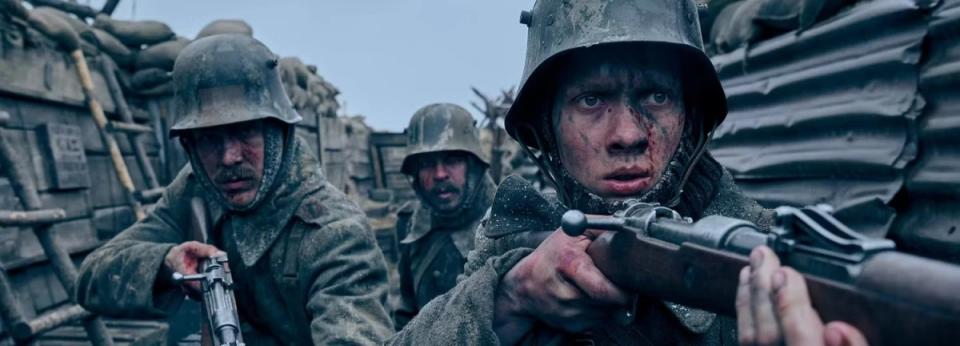‘All Quiet On The Western Front’ Toronto Review: New German Version Of Classic WWI Novel Proves War Is Indeed Hell
- Oops!Something went wrong.Please try again later.
- Oops!Something went wrong.Please try again later.

Lewis Milestone’s 1930 classic All Quiet on the Western Front was based on the 1928 novel by Erich Maria Remarque and became the first adaptation of a book to win the Oscar for Best Picture, as well as the first Best Picture Oscar winner to also take Best Director. It has hardly been touched by filmmakers since then save for a TV movie remake by director Delbert Mann in 1979 that starred Richard Thomas. Now that has changed, and in a significant way, as the book has finally been taken on by Germany with director Edward Berger’s (Patrick Melrose, Your Honor) adaptation that finally shows us the perspective from the German side. It has already been selected as the German entry for the 95th Oscars’ International Feature Film race, and just had its world premiere Monday at the Toronto Film Festival.

Deadline
More from Deadline
This Netflix film, which will also have a theatrical run, is a big-scale epic production that looks a lot more expensive than what it actually cost to make, including battle scenes that are as harrowing a depiction of the holy terror of war as any that have been presented in a movie like this. The story following a young German soldier named Paul on the western front in World War I remains just as powerful as ever, but even takes on extra gravitas at this time when another war in Europe is being waged in Ukraine, and the winds of war continue to spark conflicts at various points around the globe. The timing is again right for a movie that shows us war is not a video game, and this one does that very well.
In fact, early on there are some effective scenes showing how Paul and his friends are almost euphoric about the prospect of signing up and going to war for Germany, one scene particularly head-shaking as they appear at a gung-ho rally, thrilled to be on the cusp of going into battle. Be careful what you wish for. It all actually begins tragically, with the battlefield death of a soldier who met his end in the line of fire from French machine guns. Before he finds his final resting place in a mass grave, his uniform and boots are removed and then sent back home to be recycled for another soldier. In this case that is Paul Baumer (Felix Kammerer), who is just 17 and still in high school, but eager to go fight the French.
It is no game as he and other soldiers soon find out during an attack where he is on the front. In the rainy trenches and swamps Paul meets Katczinsky (Albrecht Schuch), who seems a bit wiser than the rest including Paul’s classmate Ludwig (Adrian Grunewald), as well as his best buddy Albert Kropp (Aaron Hilmer) who is there as a bullet nearly kills Paul, another sign this is not going to be a cakewalk. Another friend, Tjaden (Edin Hasanovic) warns of an even more intense and imminent French attack, and in this spectacular set piece staged by Berger, Paul is buried under rubble only to eventually awaken and forced to perform the solemn duty of collecting dog tags from the many dead including Ludwig. He’s devastated, but it is just the beginning.

Netflix
The story advances then by 18 months to November 1918, and things have gone quickly downhill for the Germans. A realistic and liberal political figure Erzberger (Daniel Brühl) tries convincing his superiors to give it up and just sign a ceasefire. It’s over, or so he thinks. As this back and forth goes on with an unbending French team demanding complete and unqualified surrender, and nothing less, there is that “all quiet” on the western front so Paul and Kat have time for a lighter moment, sneaking on to a farm and going after one of the geese they intend to eat. It is time also to think about war’s end and getting back to loved ones including Kat’s wife who sends a letter. New recruits don’t even make it to the front lines though, victims of gas attacks. The outlook is bleak.
Meanwhile, Erzberger is at odds with Gen. Friedrich (Devid Striesow) who is a warmonger convinced they should keep it going until the very end — never give up as that is treason But Erzberger is under extreme pressure and given only 72 hours to sign. More death and human tragedy follows during this period as Paul sees truly awful things, including the effect of men burning alive due to errant cannon fire; this part is truly horrifying and Berger doesn’t hold back on showing the results. As the suits negotiate (if you call it that) and the end is declared, Friedrich has other ideas.
It is hard to try to remake a film that is considered a classic (and even though released 92 years ago still tops lists of the greatest war films ever made), much less trying to do a new take on something that won Best Picture. Berger and his co-writers, Lesley Paterson and Ian Stokell, and his crack team of artisans should be congratulated for making the attempt, and one that actually turns out to be a smart move. Why not tell this very German story from a German POV for a change? It is surprising it hasn’t been done before, but it has been done now with a film that looks very polished thanks to fine cinematography from James Friend, production design from Christian M. Goldbeck, and a terrific score by Volker Bertelmann. Editing by Sven Budelmann is also excellent, and even at 147 minutes this thing moves.
Kammerer is very fine in the key role of Paul, and also Schuch has his moments. Among the bosses, Brühl is strong, as is Thibault De Montalembert, and Striesow. Producers are Malte Grunert, Daniel Dreifuss and Berger.
Netflix begins streaming it on October 28. Let’s hope those foolish leaders around the world waging war, or threatening to, are watching. Berger proves here that All Quiet on the Western Front still packs a very loud punch.
Best of Deadline
NFL 2022 Schedule: Primetime TV Games, Thanksgiving Menu, Christmas Tripleheader & More
The Queen Onscreen: 15 Actresses (And Actors) Who've Played Elizabeth II In Film And On TV
'Blonde' Premiere Photo Gallery: Ana de Armas Channels Marilyn Monroe At Venice Film Festival
Sign up for Deadline's Newsletter. For the latest news, follow us on Facebook, Twitter, and Instagram.

